To combat teeth discoloration from smoking, you can consider using over-the-counter whitening products. These vary in effectiveness, so it's crucial to choose carefully based on your needs and budget. Opt for professional treatments for severe discoloration, while natural remedies can be gentle for mild staining. Before commencing any treatment, consult with a dental professional to guarantee the best results. By following a step-by-step guide with the right product and maintaining good oral hygiene habits, you can achieve whiter teeth. Keep in mind the importance of consistent care and avoid staining agents for long-lasting effects.
Key Points
- Consider professional treatments for deep stains caused by smoking.
- Choose over-the-counter products for mild to moderate discoloration.
- Consult with a dentist before starting any whitening treatment.
- Maintain oral hygiene to prolong whitening results.
- Avoid staining agents like smoking, coffee, and red wine for whiter teeth.
Causes of Teeth Discoloration in Smokers
When you smoke, the tar and nicotine in cigarettes can lead to teeth discoloration, causing your once-white teeth to turn yellow or brown over time. Nicotine, a key component of tobacco, constricts blood vessels, reducing the flow of saliva in your mouth. This decrease in saliva production can result in a dry mouth, allowing bacteria to thrive and leading to plaque buildup. Additionally, the effects of nicotine include staining teeth and weakening enamel, making them more susceptible to discoloration.
Moreover, tar buildup from smoking can seep into the microscopic crevices of your tooth enamel, causing deep stains that are difficult to remove with regular brushing alone. The porous nature of enamel allows these substances to penetrate and settle, ultimately resulting in stubborn yellow or brown discoloration. Understanding how nicotine and tar affect your teeth is essential in choosing the most effective whitening options to restore your smile's natural brightness.
Understanding Over-The-Counter Whitening Products
Smokers looking to address teeth discoloration caused by tar and nicotine buildup may find value in exploring over-the-counter whitening products as a potential solution. These products can help improve the appearance of stained teeth, providing a convenient option for those seeking to whiten their smiles at home.
When considering over-the-counter whitening products, keep the following points in mind:
- Effectiveness: Over-the-counter whitening products vary in effectiveness. Look for products containing ingredients like hydrogen peroxide or carbamide peroxide for better results.
- Safety: Verify the product is safe for home use by following the instructions carefully and not overusing the product.
- Cost: Over-the-counter whitening products are generally more affordable than professional treatments, making them a budget-friendly option.
- Limitations: While over-the-counter products can help with mild to moderate staining, severe discoloration may require professional treatments or natural remedies for better results.
Tips for Choosing the Right Whitening Solution
To guarantee excellent results in whitening your teeth, consider these important factors when selecting the right whitening solution for your needs.
When choosing a whitening solution, it's crucial to compare the options between professional treatments and natural remedies. Professional options, such as in-office treatments or take-home kits provided by dentists, offer stronger bleaching agents and quicker results. These methods are effective but can be more expensive.
On the other hand, natural remedies like baking soda, activated charcoal, or hydrogen peroxide may take longer to show results but are often gentler on teeth and gums. Consider your budget, desired outcome, and any sensitivity concerns when making your decision.
It's also advisable to consult with a dental professional before starting any whitening treatment to ensure it's suitable for your oral health. By carefully evaluating these factors, you can choose the right whitening solution that aligns with your preferences and needs.
Step-by-Step Guide to Using Whitening Products
Consider your whitening goals and proceed with confidence by following this detailed step-by-step guide on effectively using whitening products.
- Choose the Right Product: Select a whitening product that suits your needs, whether it's whitening strips, trays, or toothpaste with whitening agents.
- Follow Directions Carefully: Adhere to the instructions provided with the product for best results. Overuse can lead to sensitivity and gum irritation.
- Brushing Techniques: Prior to using the whitening product, brush your teeth gently using fluoride toothpaste to remove any surface stains and plaque buildup.
- Preventing Stains: Avoid smoking, excessive coffee, tea, or red wine consumption, as these can contribute to staining. Adopting healthier habits can help maintain your newly whitened smile.
Maintaining Whiter Teeth After Treatment
To maintain the brightness of your teeth after whitening treatment, it's essential to establish a consistent oral hygiene routine incorporating important measures against staining agents. Brush your teeth at least twice a day with a whitening toothpaste that helps uphold the results of your treatment. Floss daily to remove any food particles that could lead to staining. Consider using a mouthwash that helps prevent staining and upholds the whiteness of your teeth.
In addition to your oral hygiene routine, making lifestyle changes can greatly impact the long-term results of your whitening treatment. Avoid foods and beverages known to stain teeth, such as coffee, tea, and red wine. If you do consume these items, rinse your mouth with water afterward. Quitting smoking not only benefits your overall health but also helps maintain your newly whitened teeth. Regular dental check-ups and cleanings are important for monitoring the whiteness of your teeth and addressing any potential issues promptly. By incorporating these habits into your daily routine, you can enjoy a brighter smile for the long term.
Frequently Asked Questions
Can Smoking Cessation Alone Help in Whitening Smoker's Teeth?
Yes, smoking cessation can help whiten smoker's teeth. By quitting smoking, you reduce exposure to harmful chemicals that stain teeth. This lifestyle change can gradually improve teeth color. Consider professional whitening options for faster results.
Are There Any Long-Term Effects of Using Whitening Products on Smoker's Teeth?
As you explore whitening options, consider the risks involved. Long-term implications of using whitening products on smoker's teeth may include increased sensitivity and potential damage to tooth enamel. Prioritize dental health with informed decisions.
How Often Should Smoker's Teeth Be Whitened to Maintain Results?
To maintain results, you should consider regular maintenance of whitening treatments for smoker's teeth. The frequency of whitening can vary but typically ranges from every 6 months to once a year for best outcomes.
Are There Any Natural Remedies for Whitening Smoker's Teeth?
For those seeking natural remedies to whiten smoker's teeth, herbal remedies like baking soda and DIY treatments such as coconut oil pulling can be effective. These methods offer safety and effectiveness in brightening your smile.
Can Professional Dental Cleanings Help in Whitening Smoker's Teeth?
Yes, professional dental cleanings can greatly help in whitening smoker's teeth. These dental procedures are highly effective at removing surface stains and tartar buildup. However, lifestyle changes like quitting smoking can have a greater impact on long-term whitening results.
Conclusion
Now that you have learned about the causes of teeth discoloration in smokers and the various whitening options available, it's time to take action and brighten your smile.
Remember, a brighter smile can boost your confidence and leave a lasting impression.
So, don't wait any longer – choose the right whitening solution, follow the step-by-step guide, and maintain those pearly whites for a dazzling smile that shines like a diamond in the rough.



